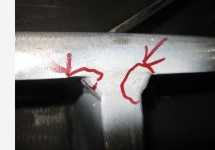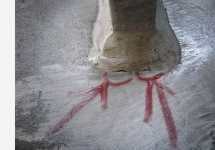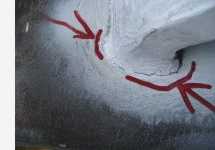SERVICES » Testing
Badania
 We offer a wide range of non-destructive testing in the NDT multisector (welded joints, low-alloy steels, high-alloy steels, forgings, castings, pressure vessels):
We offer a wide range of non-destructive testing in the NDT multisector (welded joints, low-alloy steels, high-alloy steels, forgings, castings, pressure vessels):
• VT - visual testing - is the simplest method of obligatory non-destructive testing conducted on all kinds of welded structures. These tests are based on visual assessment of welds and due to that they do not require large amounts of time and do not incur high costs.
This method requires very high competences and experience from the person executing the test. Typical defects that can be diagnosed thanks to this method are:
- surface defects caused in the process of production (especially cracks, undercuts, inclusions, porosity),
- dimensional deviations,
- defects caused during assembly,
- defects caused in the process of structure exploitation (leaks, corrosions, fatigue cracks).
The VT method is the preliminary stage of full-scope tests by means of further methods and should be treated more as a complement of thorough non-destructive testing.
 • PT - penetrant testing - conducted on materials belonging to a group of carbon and alloy steel, alloys of aluminium, copper or titanium, and ceramics. This method has wide application in checking for leaks in welded tanks etc. Penetrant testing can be used for ferromagnetic, nonferromagnetic and nonmetallic materials.
• PT - penetrant testing - conducted on materials belonging to a group of carbon and alloy steel, alloys of aluminium, copper or titanium, and ceramics. This method has wide application in checking for leaks in welded tanks etc. Penetrant testing can be used for ferromagnetic, nonferromagnetic and nonmetallic materials.
• MT - magnetic particle testing - a method of non-destructive testing possible to be carried out on ferromagnetic materials, i.e. iron, nickel, cobalt or their alloys; welded, thermally treated. This method allows us to detect surface and sub-surface defects: cracks, laps, porosity. It is based on magnetising the tested element and detecting magnetic field dispersion which appears in areas of discontinuities. The sensitivity of magnetic particle testing is defined by the width and depth of detected flaws. MT testing enables us to detect the most dangerous surface and sub-surface discontinuities such as: fatigue cracks, hardening cracks, grinding cracks, forging cracks, inclusions, welding cracks, tears, laps.
 • UT - ultrasonic testing - this method utilises the phenomenon of ultrasonic wave propagation in solid substances. It is used to detect flaws, make assessment and dimensioning, establish material properties. It also makes it possible to detect dangerous internal, surface and sub-surface material discontinuities. A significant advantage of this method is the speed of gathering information, high rate of accuracy, universality and effectiveness. UT tests are carried out by means of through-transmission technique or by pulse-echo technique. The ultrasonic method encompasses tests of elements from ferritic and austenitic steels, aluminium, magnesium, copper and its alloys, lead, nickel and ceramics.
• UT - ultrasonic testing - this method utilises the phenomenon of ultrasonic wave propagation in solid substances. It is used to detect flaws, make assessment and dimensioning, establish material properties. It also makes it possible to detect dangerous internal, surface and sub-surface material discontinuities. A significant advantage of this method is the speed of gathering information, high rate of accuracy, universality and effectiveness. UT tests are carried out by means of through-transmission technique or by pulse-echo technique. The ultrasonic method encompasses tests of elements from ferritic and austenitic steels, aluminium, magnesium, copper and its alloys, lead, nickel and ceramics.
• UTT - ultrasonic thickness testing,
Examining pressure equipment for cutting and welding in accordance with the guidelines of Minister of Economy.
We cooperate with certified laboratories in the area of destructive testing, material structure tests.






